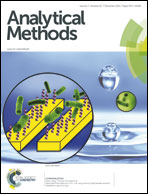A novel ternary system for the determination of ascorbic acid concentration based on resonance Rayleigh scattering
Abstract
The dienol of ascorbic acid was observed to have a strong reducing power in a 1.44 M HCl buffer solution, and could reduce Fe3+ to Fe2+. The resulting Fe2+ was allowed to react with K3Fe(CN)6 to form the ion-association complex Turnbull's blue, which resulted in the enhancement of resonance Rayleigh scattering (RRS), second order scattering (SOS) and frequency doubling scattering (FDS). The maximum scattering intensities occurred at wavelengths of 374 nm, 540 nm and 395 nm, respectively. The scattering intensities of the three methods were proportional to the concentration of ascorbic acid in a certain range. RRS was found to be the most sensitive method here, and its detection limit for ascorbic acid was 5.0 ng mL−1. The experimental conditions were optimized and the effects of coexisting substances were evaluated. The method showed excellent selectivity, because relatively high amounts of common ions, acid groups, urea, amino acid, saccharides and protein were found not to influence the measurement. Accordingly, a novel, rapid, convenient, sensitive and selective RRS method for determination of ascorbic acid concentration has been proposed, and applied to detect ascorbic acid in tablets and human serum samples with satisfactory results. The reaction mechanism and causes of the resonance light scattering intensity enhancement are also discussed.


 Please wait while we load your content...
Please wait while we load your content...